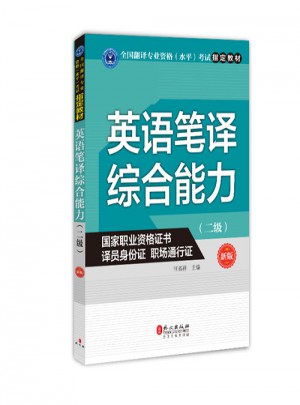
英語筆譯綜合能力(二級)(新版)
- 所屬分類:圖書 >外語>英語專項訓(xùn)練>翻譯
- 作者:[汪福祥] 主編
- 產(chǎn)品參數(shù):
- 叢書名:--
- 國際刊號:9787119108605
- 出版社:外文出版社
- 出版時間:2017-07
- 印刷時間:2017-07-01
- 版次:1
- 開本:16開
- 頁數(shù):226
- 紙張:膠版紙
- 包裝:平裝-膠訂
- 套裝:否

本指定教材是根據(jù)全國翻譯資格(水平)考試英語二級翻譯口筆譯大綱(修訂版)中相關(guān)內(nèi)容的變動和更新編寫而成,較之以前各版本相比,無論在選材、體例、結(jié)構(gòu)還是在思想組織、內(nèi)容編排以及知識點和要點設(shè)計等方面,均有較大程度的改進(jìn),使本教材對讀者筆譯綜合能力的提高更具點撥性和現(xiàn)實意義。本書共分七章。 章“綜述”,主要用以闡釋筆譯綜合能力與翻譯水平的關(guān)系,涉及綜合能力提高的內(nèi)容及方法。第二章的“詞匯選擇”和第三章的“詞匯替換”,在引領(lǐng)讀者捕捉試題題干語義取向的基礎(chǔ)上,著重介紹、闡釋選詞抉擇所要經(jīng)歷的思考點和思考路徑。第四章的“語法改錯”,在討論甄別題干錯誤的基礎(chǔ)上,重點介紹涉及修正錯誤的幾個要點,為改”提供思路的指引。第五章的“閱讀理解”,通過對內(nèi)容各有側(cè)重的試題及答題之思維過程的分析,重點介紹牽涉語篇理解和信息捕捉的幾種策略以及答題所應(yīng)關(guān)注的幾個關(guān)鍵環(huán)節(jié)和要點。第六章的“完形填空”,在考察讀者語篇和語境意識以及語感的基礎(chǔ)上,重點介紹完形的思考步驟、思考方法以及涉及答題的要領(lǐng)和知識點。第七章包含兩套綜合測試題,為讀者提供個自我測試、自我檢驗、自我提高的機(jī)會,目的是使讀者通過接近真題的答題實踐知彼知己:既了解自己的優(yōu)勢所在,也覺察、感知到自己在某方面存在的不足,為綜合能力的進(jìn)一步提高找到攻關(guān)的突破口和路徑。
作為一本提高英語筆譯綜合能力的教材,本書的構(gòu)思和內(nèi)容編排,以“授之以魚”為載體,盡可能地使大家獲得“得之以漁”的進(jìn)學(xué)成效。基于此宗旨,每一章都以“綜述”開篇,而在每章之內(nèi)五個部分(Section)中所提供的試題前,均有“導(dǎo)言”做讀者答題的“意識引領(lǐng)”,緊隨其后的便是針對每道題的答題給出的“答題注釋”。跟隨“答題注釋”的是每一部分的“小結(jié)”,用以對知識點的歸納、總結(jié)和梳理。總的說來,如果把每道試題比作“授之以魚”的“魚”,那么題后的“答題注釋”就有似于向讀者提供的“授之以漁”的“漁”,而開篇的“導(dǎo)言”和收尾的“小結(jié)”便是對讀者“收魚”之前思考路向的引領(lǐng)和“收魚”之后的感悟和總結(jié)。不妨說,本教材所“授”之“魚”,為讀者提供了身臨其境的練習(xí)機(jī)會,而伴隨而來的所“得”之“漁”,便是讀者提高英語筆譯綜合能力的一種經(jīng)驗的積累,為綜合能力的提升奠定基礎(chǔ)。
汪福祥,男,(原)北京第二外國語學(xué)院教授,研究生導(dǎo)師,曾任英語系副主任、翻譯學(xué)院副院長,全國翻譯專業(yè)資格(水平)考試英語專家委員會委員。
目 錄
UNIT 1 On the Improvement of Comprehensive Performances in CATTI
綜合能力提高綜述
UNIT 2 Vocabulary Selection 詞匯選擇
Section 1: A General View of the Task
詞匯選擇題型總覽
Section 2: To Get Hold of the Sentence’s Meaning
把握題干的語義取向
Section 3: Glossary Selection According to the Contexts
語境參照下的詞匯選詞
Section 4: Lexical Collocations
詞匯搭配
Section 5: Idiomatic Expressions
習(xí)慣用語
UNIT 3 Vocabulary Replacement 詞匯替換
Section 1: Get Hold of the Intended Meaning of the statement
把握題干語句的語義取向
Section 2: The Context and Glossary Replacement
語境參照與詞語替換
Section 3: Sentence Analysis and Glossary Replacement
句子分析與詞匯替換
Section 4: Contextual Meanings of the Glossary
結(jié)構(gòu)成分與詞義判別
Section 5: Collocations and Idiomatic Expressions
固定搭配與習(xí)慣用語
UNIT 4 Error Correction 語法改錯
Section 1: Spot out the Grammatical Errors
語法錯誤的判別
Section 2: Pin-point out the Errors in Collocations
詞語搭配錯誤的甄別
Section 3: Appropriate Use of Idiomatic Expressions
習(xí)慣用語的正確使用
Section 4: Recognize the Structural Errors
句子結(jié)構(gòu)錯誤的判別
Section 5: The Semantic and Loghical Relationship
語義及邏輯關(guān)系的判別
UNIT 5 Reading Comprehension 閱讀理解
Section 1: Get Hold of the Theme of the Writing
把握文章的主旨
Section 2: Decide on the “False” and “True”
“是”與“非”的甄別與判斷
Section 3: Dig into the Lexical and Semantic Details
掘進(jìn)思想表達(dá)的細(xì)節(jié)
Section 4: Rule out the “False” for the “True”
“是”與“非”的判斷與排除
Section 5: Generalize and Synthesize the Message
概括歸納分析題型
UNIT 6 Cloze Test 完形填空
Section 1:Selection Through Contextual and Logical Analysis
選詞的語境和邏輯分析
Section 2:Grammatical Analysis and Lexical Collocations
語法分析與詞語搭配
Section 3: Contextual Reference and Glossary Connection
語境參照與詞語關(guān)聯(lián)
Section 4: Structural Analysis and Glossary Selection
結(jié)構(gòu)分析與詞匯選擇
Section 5: Semantic Analysis and Glossary Selection
語義分析與詞匯選擇
UNIT 7 A General Test for Self-evaluation 綜合測試
Test One 測試一
Test Two 測試二